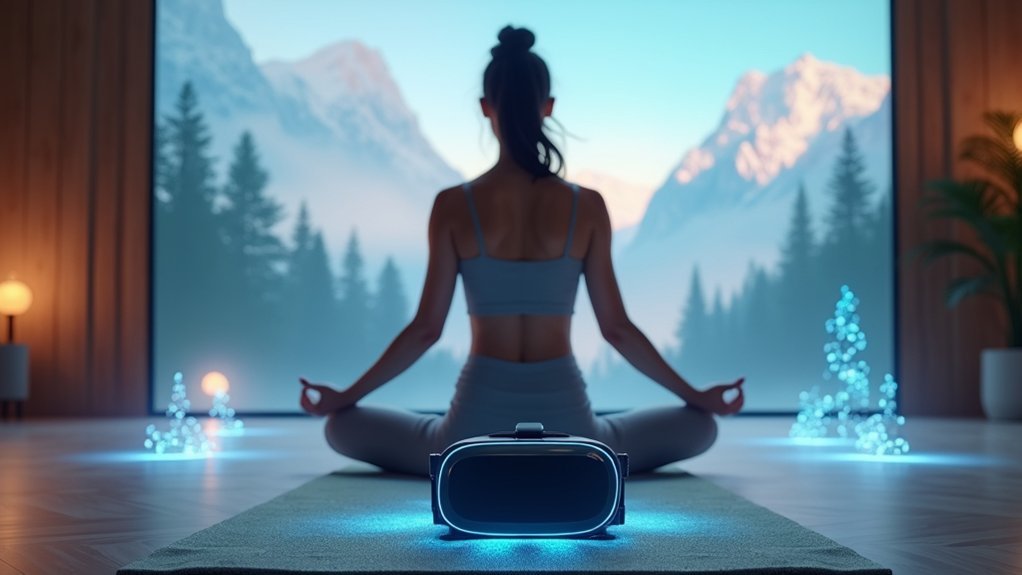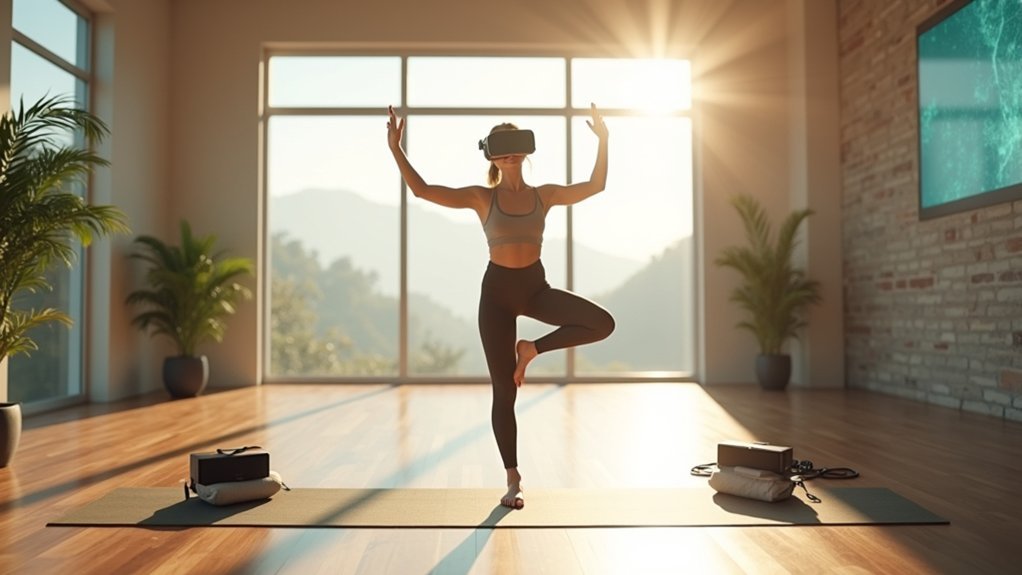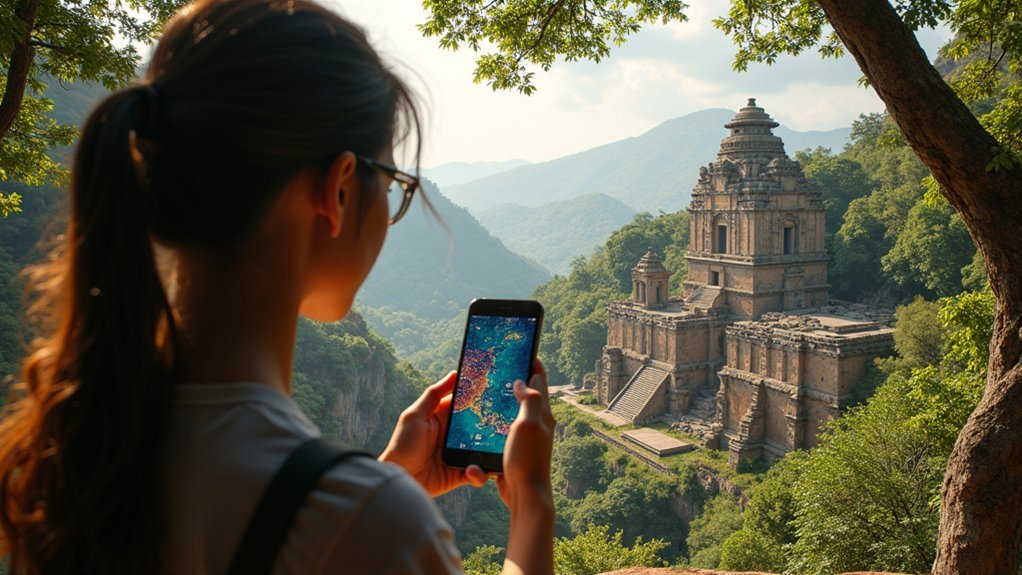To become a VR yoga instructor, you’ll need to complete a 200-hour yoga teacher training program accredited by Yoga Alliance, then master VR technology including headsets like Oculus Quest 2 and specialized software platforms. You must adapt traditional teaching methods for virtual environments, focusing on verbal cues and visual demonstrations rather than physical adjustments. Develop interactive sessions using motion tracking and gamification elements while building online communities through social features. The strategies below will transform your teaching practice into an immersive digital experience.
Understanding Virtual Reality Technology for Yoga Instruction

While traditional yoga studios remain popular, virtual reality technology is revolutionizing how instructors can deliver immersive yoga experiences to students worldwide.
You’ll need to understand how VR creates simulated environments like beaches or forests that enhance relaxation and focus during practice. This virtual training platform enables real-time interaction between you and students, providing personalized feedback similar to in-person classes.
VR notably increases engagement in physical activities, with participants reporting higher satisfaction and motivation levels. You can reach global audiences regardless of location, expanding your client base and revenue potential.
As you consider online yoga teacher training, remember the VR fitness market is projected to reach $1 billion by 2025, indicating tremendous growth opportunities.
Essential VR Equipment and Software Requirements
Three key pieces of equipment form the foundation of your VR yoga instruction setup. Your VR headset serves as the primary interface, with options like the Oculus Quest 2 or HTC Vive delivering immersive experiences for students.
You’ll also need a compatible computer or gaming console that provides sufficient processing power and storage capacity for demanding applications.
Specialized VR software platforms such as VRChat, Engage, or AltspaceVR enable you to create and manage classes within virtual environments. These applications allow seamless interaction with students and customizable session settings.
High-quality audio equipment completes your setup. A professional microphone guarantees clear communication, while good headphones help you monitor sound quality and maintain immersion throughout sessions.
Mastering these platforms’ user interfaces assures smooth navigation and professional instruction delivery.
Obtaining Your Foundational Yoga Teacher Certification

Beyond mastering the technical aspects of VR equipment, you’ll need legitimate yoga credentials to establish yourself as a qualified instructor.
Your journey begins with completing a yoga teacher training certification, typically a 200-hour program that’ll teach you essential yoga philosophy, anatomy, and teaching methodologies.
Choose a program accredited by Yoga Alliance to guarantee industry recognition and credibility. This certification opens doors to various yoga styles like Vinyasa, Yin, or Ashtanga, allowing you to specialize based on your interests and target audience.
During training, you’ll engage in personal practice while applying learned concepts, preparing you for real-world teaching scenarios.
The thorough program includes live sessions, practical teaching experience, and assessments to certify your readiness as a certified yoga instructor.
Adapting Traditional Yoga Practices for Virtual Environments
As you shift from traditional studio teaching to virtual reality instruction, you’ll discover that adapting yoga practices for VR environments requires reimagining how you connect with students through the digital space.
Your cueing techniques must evolve beyond physical adjustments to emphasize clear verbal instructions and detailed visual demonstrations. Since students can’t feel your hands-on corrections, you’ll need extensive online training to master VR-specific teaching methods.
| Traditional Method | VR Adaptation | Key Consideration |
|---|---|---|
| Physical adjustments | Verbal cuing only | Clear spatial directions |
| Mirror feedback | 360-degree views | Enhanced visual guidance |
| Group energy | Interactive features | Digital community building |
| Studio ambiance | Immersive environments | Customizable atmospheres |
Teaching yoga in virtual environments means yoga instructors must prioritize safety through explicit boundary guidelines while leveraging gamification elements to maintain student engagement without compromising mindfulness principles essential to authentic yoga practice.
Designing Immersive VR Yoga Class Experiences

When designing immersive VR yoga class experiences, you’ll transform traditional sessions into multisensory journeys that transport students beyond physical studio limitations.
Create 360-degree environments featuring beaches, mountains, or forests where students practice in tranquil settings. Integrate advanced motion tracking technology that provides real-time posture feedback and personalized alignment adjustments. Layer ambient soundscapes and music that complement your chosen environment, enhancing the immersive experience through multisensory engagement.
Implement gamification elements like challenges and rewards to boost participation and build virtual community connections. Design accessible experiences accommodating various skill levels and physical abilities, ensuring inclusivity.
When completing online teacher training school programs, you’ll learn these VR-specific techniques that distinguish virtual yoga instruction from traditional methods. Focus on seamless technology integration that supports rather than distracts from the yoga practice itself.
Creating Interactive Virtual Yoga Sessions
Building on your immersive environment foundation, you’ll need to focus on fostering real-time engagement between yourself and your students. As an online teacher, you’ll utilize motion tracking technology to provide immediate pose corrections through virtual avatars. Your yoga certification becomes valuable when implementing these interactive features effectively.
| Interactive Element | Purpose |
|---|---|
| Real-time feedback | Correct posture instantly |
| Group discussions | Build community connections |
| Partner exercises | Encourage collaboration |
| Gamification rewards | Boost participation rates |
Design your interactive yoga sessions with community-building features like collaborative challenges and group conversations. Incorporate points and rewards systems to maintain student motivation and commitment. Ascertain your virtual environment delivers high-quality audio and visual components, as these elements are essential for maintaining focus and delivering clear instruction throughout your sessions.
Building Your VR Yoga Studio Setup
Five essential components form the foundation of your professional VR yoga studio setup.
You’ll need top-tier equipment and thoughtful environment design to deliver exceptional immersive experiences for your students.
- High-quality VR headset: Invest in Meta Quest 2 or HTC Vive for comfortable, extended yoga classes that won’t strain your students during longer sessions.
- Spacious, clutter-free space: Create a safe physical environment that allows unrestricted movement without obstacles or hazards during virtual reality practice.
- Specialized VR software platforms: Use Oculus Venues or AltspaceVR to host interactive yoga classes and connect with students in virtual settings.
- Enhanced lighting and sound systems: Install calming ambient lighting and background music to complement the virtual atmosphere.
- Regular equipment maintenance: Keep your VR headset and software updated, troubleshooting technical issues before each session begins.
Developing Your Unique VR Teaching Style
Authenticity becomes your greatest asset when developing a distinctive VR teaching style that resonates with students across virtual environments.
Start by experimenting with different VR platforms to understand their capabilities and limitations. This knowledge helps you craft an effective teaching approach that maximizes the medium’s potential.
Integrate interactive elements like virtual props and avatars to create a truly immersive experience. Your yoga philosophy from previous yoga teacher training courses should seamlessly translate into the VR format, becoming your unique selling proposition that differentiates you from other instructors.
Continuously gather student feedback during sessions to refine your methods.
Explore various virtual environments—from tranquil nature scenes to calming studios—to discover the perfect backdrop that enhances relaxation and focus while supporting your distinctive teaching methodology.
Marketing Your Virtual Reality Yoga Services
Marketing your virtual reality yoga services requires strategic positioning that leverages the innovative nature of your offering.
You’ll need to establish credibility through proper certification course credentials while highlighting what makes virtual reality yoga uniquely appealing.
- Leverage social media platforms like Instagram and Facebook to share engaging video clips and client testimonials showcasing your immersive sessions.
- Launch targeted email campaigns emphasizing accessibility and unique VR experiences to reach interested demographics.
- Partner with fitness influencers and wellness brands for cross-promotion, expanding your audience reach.
- Offer free trials or discounted introductory sessions to let potential clients experience virtual reality yoga firsthand.
- Optimize your website with relevant SEO keywords so clients can easily discover your services on online platforms.
Engaging Students in VR Yoga Communities
While building your VR yoga practice is essential, fostering genuine connections within virtual communities transforms individual sessions into thriving ecosystems where students support each other’s wellness journeys.
Design interactive sessions that showcase VR’s unique capabilities—360-degree visuals and immersive guided meditations create engaging experiences impossible in traditional yoga online formats. Your yoga teaching should leverage social features like group classes and real-time feedback to cultivate community bonds and boost retention rates.
VR yoga transforms traditional practice through immersive 360-degree environments and real-time social connections that strengthen community bonds.
Create themed events targeting diverse demographics through nature-inspired settings or culturally-themed practices. These immersive experiences attract varied student interests while building engaging students’ loyalty.
Regularly gather feedback to refine your offerings and meet evolving preferences. This responsive approach guarantees your successful yoga instruction adapts to community needs, maintaining vibrant participation and fostering lasting connections.
Monetizing Your VR Yoga Instruction Business
You’ll need to understand different VR platform revenue models to maximize your earning potential as a virtual yoga instructor.
Most platforms offer subscription-based models, one-time purchases, or pay-per-class options that you can leverage depending on your target audience.
Setting competitive prices for your classes requires balancing affordability with the premium nature of VR experiences, typically ranging from $10-30 monthly for subscriptions or $5-50 for individual sessions.
VR Platform Revenue Models
As the VR yoga industry continues to expand, understanding diverse revenue models becomes essential for building a sustainable and profitable instruction business.
You’ll need to select strategies that align with your goals and audience preferences.
Modern yoga teachers can leverage multiple monetization approaches:
- Subscription-based models – Charge monthly fees for unlimited access to your class library and exclusive content
- Pay-per-class pricing – Offer individual sessions or package deals for students seeking flexibility
- Premium content offerings – Create specialized workshops and one-on-one coaching sessions at higher price points
- Brand partnerships – Generate income through sponsorships and affiliate marketing with fitness companies
- Freemium model – Attract users with free basic classes, then convert them to paid advanced features
Pricing Your Classes
Once you’ve selected your revenue model, setting the right price for your VR yoga classes becomes your next priority.
Research similar virtual yoga offerings to establish competitive pricing between $10-30 per class, adjusting based on your experience and content quality. Your training is worth what students perceive as valuable, so don’t undervalue yourself.
Create tiered pricing options including drop-in rates, class packages, and monthly subscriptions. This approach mirrors successful online yoga studio models and accommodates different client preferences while encouraging commitment.
Launch promotional strategies like introductory discounts and referral bonuses to attract new students.
Accept multiple payment methods through PayPal or Venmo for convenience.
Regularly reassess your pricing strategy based on student feedback and market trends to maintain competitiveness while reflecting your instruction’s true value.
Frequently Asked Questions
How Do I Become a Virtual Yoga Instructor?
You’ll need to complete a 200-500 hour yoga teacher training program, build an engaging online presence, master virtual platforms like Zoom, create quality video content, and implement marketing strategies including free classes.
Can I Make Money Teaching Yoga Online?
You can absolutely make money teaching yoga online. You’ll earn through paid classes, workshops, subscriptions, and specialized programs. Combining free content with premium offerings maximizes your income potential and builds a committed student base.
How Much Does a Virtual Yoga Class Cost?
You’ll pay $10-30 per virtual yoga session, though monthly subscriptions cost $15-40 for unlimited access. Specialized workshops can reach $50, while bulk packages offer discounts averaging $5-20 per class.
Can You Learn Yoga Virtually?
You can definitely learn yoga virtually through online platforms offering video classes and live sessions. You’ll access tutorials from home, choose flexible time slots, and often find shorter segments that fit your busy schedule perfectly.





Leave a Reply